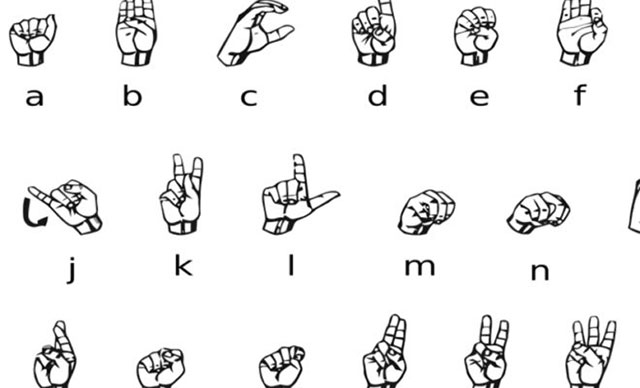New technology beyond helps sign language barriers
Good news for the deaf community in the early months of 2019. Recently, Michigan State University engineers have succeeded in developing and applying for a patent for a language support technology. Breakout symbols - unlike previous translation mechanisms - are non-invasive, compact and portable like a Chapstick lipstick.
'We are proud to announce that we have succeeded in bringing a superior sign language translation solution, a reliable companion for those who unfortunately cannot hear. How can deaf people communicate effectively with someone who doesn't understand sign language? This new technology is the solution, it will act as a virtual, personal interpreter that they can take with them anytime, anywhere, "said Mi Zhang, associate professor of electrical and computer engineering. calculated the University of Michigan, the research director said.
According to statistics, there are hundreds of thousands of hearing impaired or sufferers of hearing impairment based on American sign language system, or ASL, for daily communication. The problem is that, if there are no interpreters, they will not have the opportunity to find suitable jobs, and sometimes have trouble in sensitive situations, making these people inherently disadvantaged in life becomes even more disadvantaged.

- Smart toilets can help protect users against heart failure
Suppose, think about whether you are deaf, in the hospital and need to contact the doctor, you will have to wait for the interpreter to sign the hospital's or your loved one's language. Or worse, no one can understand the message you try to convey, which can lead to real tragedies, harm your privacy, or even be dangerous. live. This is just a small example of the important need for sign language translation technology.
Associate Professor Zhang and colleagues, including Dr. Biyi Fang and several other experts from Jillian Co University, have seen and successfully implemented an opportunity to help deaf people overcome barriers. in communication and having an easier life. Specifically, Mi Zhang's technology and colleagues are called DeepASL, which are applied to deep learning or data-based learning, inspired by the structure and function of the brain along with related algorithms. through it, you can automatically recognize the meaning and translate the symbols into English.

The technology works via a 3-inch sensor, developed by Leap Motion, and will, of course, be equipped with cameras to record hand and finger movements continuously as well. use sign language.
"The sensor will simulate and convert the movement of a person's hand and finger into a structure of joints. After that, our deep learning algorithm will collect data from joints that Leap Motion collects. and analyzed, compared with ASL symbols ", explained Mr. Mi Zhang.
- How can IoT help you enjoy 4.0-style meals?
Similar to Siri settings on iPhone, users can sign certain words to the algorithm and sensors get used to their hand and joint movements. In addition, users can also create custom signs for their names, or words that are not in the dictionary by spelling them, making it easier and more comfortable to communicate.
One feature that makes the difference of DeepASL is that it can translate complete sentences without requiring users to pause after each symbol, while previous sign language translation technologies are only available. can translate words and therefore, users will have to pause between symbols, very inconvenient, time-consuming, and can even lead to misunderstandings, making conversations difficult and awkward in some situations.
"In addition, our technology is not invasive to users. Unlike some other interpreting technologies that require users to wear gloves, making them feel marginalized because others can see it. your disability literally ".
In addition to being able to help deaf people communicate with people around, DeepASL can also help ASL learners by providing real-time feedback on their notation. Previously, self-study through instructional videos contained many limitations.
"About 90% of children with congenital deafness communicate with their parents through sign language. These parents are learning sign language to communicate with their children but often do not have time to attend classes. studying directly, so self-study will face many difficulties.Our technology can provide assessments to help learners improve quickly, "said Zhang.

- Generating electricity from WiFi promises that the future of smartphones without batteries still works well
The mechanism of operation of DeepASL technology is to convert the sign language into a verbal conversation, which is generally useful in many situations, not just to support deaf people. The researchers said the next step for the new technology would be commercialization, making it possible for hundreds of thousands of deaf people to need a smart, compact interpreter. With the retail price expected to be around 78 USD, this device can completely become a reasonable choice for those who are not too surplus. In addition, the team also plans to develop this technology to be compatible with the iPhone, as well as learning the different sign languages themselves.
You should read it
- How to fix Language bar loss error on Windows 10
- Overview of R language, install R on Windows and Linux
- Programming blockchain part 1: C ++ programming language
- Vietnamese translation for Windows 10
- How to turn off automatic language translation in Google Chrome
- SIGN functions in SQL Server
- How does Sign in with Apple work?
- How to translate many languages on Siri iOS 11
May be interested
- How to Sign Out of Windows 10
 do you want to sign out of windows 10, but can't seem to find the option to do so? signing out of windows does not shut down your computer and lets you sign in to another user account. scroll down to the first step to get started. *before...
do you want to sign out of windows 10, but can't seem to find the option to do so? signing out of windows does not shut down your computer and lets you sign in to another user account. scroll down to the first step to get started. *before... - Enable / disable the Language bar on Windows 10
 the language bar is used to quickly change the keyboard layout or input language without having to navigate to control panel or settings.
the language bar is used to quickly change the keyboard layout or input language without having to navigate to control panel or settings. - Using the 'Sign In With Google' option is risky and there is currently no workaround
 researchers have found that using this feature as an employee of a business can put you at risk of having your privacy violated, and worse, there's no fix yet.
researchers have found that using this feature as an employee of a business can put you at risk of having your privacy violated, and worse, there's no fix yet. - The reason why C programming language is never outdated
 ieee spectrum magazine ranked c as the leading language in 2017 before both java, c # and javascript. if you study c this year, it won't waste your time and effort. here are five reasons why.
ieee spectrum magazine ranked c as the leading language in 2017 before both java, c # and javascript. if you study c this year, it won't waste your time and effort. here are five reasons why. - How to insert a signature into PDF on Mac
 you can create signatures and use it to sign very simple documents on a mac. no need to download new applications, no need for online services.
you can create signatures and use it to sign very simple documents on a mac. no need to download new applications, no need for online services. - How to fix 'We can't sign into your account' error on Windows 10
 some windows 10 insider build 20226 users have reported that they were unable to log in to user profile (s) as expected. microsoft now offers a solution for help with this problem.
some windows 10 insider build 20226 users have reported that they were unable to log in to user profile (s) as expected. microsoft now offers a solution for help with this problem. - Test on C programming P6
 are you a fan of c programming language and want to learn about this programming language? the quiz below the network administrator has edited and sent you questions about this topic, invite you to experience.
are you a fan of c programming language and want to learn about this programming language? the quiz below the network administrator has edited and sent you questions about this topic, invite you to experience. - How to change language on Windows 10 computer
 see now how to change the language on your windows 10 computer. helps you proactively change the language quickly during your study and work process.
see now how to change the language on your windows 10 computer. helps you proactively change the language quickly during your study and work process. - Test on C programming P4
 the c language is the most widely used computer language, along with the java language, the leading popular programming languages, widely used in modern developers. below, invite readers to test their knowledge on this topic through the multiple-choice questions below.
the c language is the most widely used computer language, along with the java language, the leading popular programming languages, widely used in modern developers. below, invite readers to test their knowledge on this topic through the multiple-choice questions below. - How does the 'Sign-In with Google' option work?
 when you use sign-in with google to access a website or app, one of the key benefits is that google never shares your password with the website or app.
when you use sign-in with google to access a website or app, one of the key benefits is that google never shares your password with the website or app.










 Leaks information about Microsoft's new Remote Desktop application
Leaks information about Microsoft's new Remote Desktop application Apple will release a completely new 16-inch MacBook Pro and a 32-inch 6k screen this year?
Apple will release a completely new 16-inch MacBook Pro and a 32-inch 6k screen this year? Huawei P30, Huawei's most popular flagship of 2019, has set its launch date
Huawei P30, Huawei's most popular flagship of 2019, has set its launch date Xiaomi officially announced the first images of the Mi 9 Explorer smartphone with a 'transparent' back.
Xiaomi officially announced the first images of the Mi 9 Explorer smartphone with a 'transparent' back. Kali Linux 2019.1 was officially released
Kali Linux 2019.1 was officially released Opera launched new updates for Android devices with many noticeable improvements
Opera launched new updates for Android devices with many noticeable improvements